Iran’s architectural landscape is a rich tapestry woven with the threads of history, culture, and art. Spanning thousands of years, Iranian architecture is not merely about the construction of buildings; it is a narrative of a civilization that has evolved through various empires, dynasties, and cultural transformations. From the grandeur of ancient Persian empires to the intricate designs of Islamic architecture, and onto the modern-day fusion of traditional and contemporary styles, each phase in Iranian architectural history tells a unique story.
This comprehensive exploration delves into the depths of Iranian architecture, starting with the awe-inspiring structures of the ancient Achaemenid Empire. These early constructions set the stage for a distinctive architectural style characterized by monumental designs, innovative use of materials, and an emphasis on aesthetic grandeur. As we traverse through time, we witness how Iranian architecture absorbed and integrated various influences, particularly during the Islamic period, where the fusion of Persian traditions with Islamic motifs led to the creation of some of the most iconic structures in the world.
The journey through Iran’s architectural evolution is also a reflection of the country’s socio-political changes. Each era, from the Parthians and Sassanians to the Qajars and Pahlavis, brought its own set of influences and stylistic changes, mirroring the shifting dynamics of Iranian society. In the modern context, Iranian architecture has embraced global trends while maintaining a strong connection to its historical roots, showcasing an impressive blend of the old and the new.
This article aims to provide a thorough overview of the historical journey of Iranian architecture. It highlights the key buildings and architectural characteristics of each historical period, offering insights into how Iran’s architectural heritage has become a cornerstone of its cultural identity. Through this exploration, we not only appreciate the aesthetic beauty of these structures but also understand the rich cultural and historical narratives they embody.
Ancient Persian Architecture Era
The Ancient Persian Architecture Era, a hallmark of Iran’s architectural history, was characterized by its grand scale, intricate designs, and innovative engineering. This era primarily encompasses the period of the Achaemenid Empire, stretching from 550 to 330 BC, during which Persian architecture reached unprecedented heights of sophistication and grandeur.
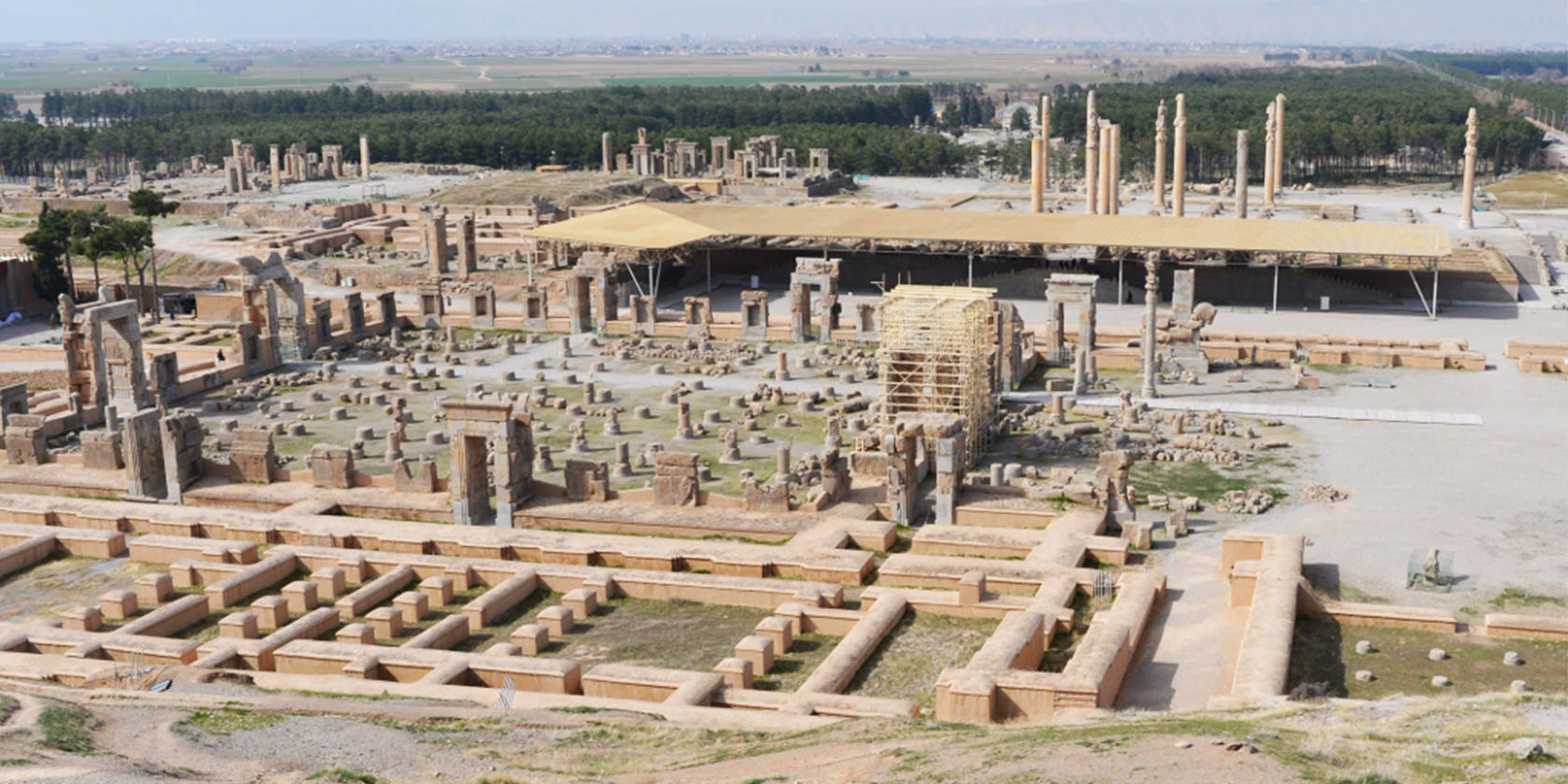
Ancient Persian Architecture Era
Key Features of Ancient Persian Architecture
– Monumental Scale: Ancient Persian buildings were often colossal, designed to display the might and wealth of the empire. This monumental scale was not just a demonstration of power but also a reflection of advanced engineering skills.
– Use of Diverse Materials: Architects of this era skillfully utilized a range of materials, including mud-brick for massive structures, limestone, and the rare use of precious metals for decorative purposes.
– Intricate Decorative Reliefs: The walls of palaces and ceremonial complexes were adorned with detailed reliefs depicting scenes of royal ceremonies, victories in battles, and depictions of the empire’s multicultural subjects.
Notable Structures
– Persepolis: The ceremonial capital of the Achaemenid Empire, Persepolis is an architectural masterpiece. Known for its majestic columns and impressive reliefs, it symbolizes the zenith of Ancient Persian architectural artistry.
– Pasargadae: The first dynastic capital of the Achaemenid Empire, Pasargadae showcases the early development of the Persian garden layout and the concept of a paradisiacal garden.
– Susa: An ancient city and winter capital, Susa’s architecture demonstrated a blend of Persian and Mesopotamian styles, reflecting the empire’s diversity.
Architectural Innovations
– Columned Halls: The use of columns to support massive roof structures was a significant innovation. The Apadana Palace at Persepolis, with its 72 columns, is a prime example.
– Drainage Systems: Advanced drainage systems in these structures, like those in Persepolis, were ahead of their time, ensuring the longevity of the buildings.
Cultural and Artistic Influence
– The architecture of this period was not just about functionality; it was a canvas for artistic expression. The integration of art with architecture in the form of bas-reliefs, statues, and intricate carvings was a distinctive feature.
– These structures were designed to be symbols of the empire’s glory and cosmopolitan nature, often incorporating elements from different parts of the empire.
The Ancient Persian Architecture Era laid the foundational principles that would influence subsequent architectural developments not only in Iran but across various regions. The scale, beauty, and technological advancements of this era’s architecture are a testament to the ingenuity and artistic vision of the ancient Persians, leaving a legacy that continues to awe and inspire.
Parthian and Sassanian Architecture Eras
The architectural journey of Iran during the Parthian and Sassanian eras marked a period of significant evolution and innovation, reflecting the changing dynamics of Persian society and the influence of political power shifts. These eras spanned from approximately 247 BC with the rise of the Parthian Empire to the fall of the Sassanian Empire in 651 AD.
Parthian Architecture Era (247 BC – 224 AD)
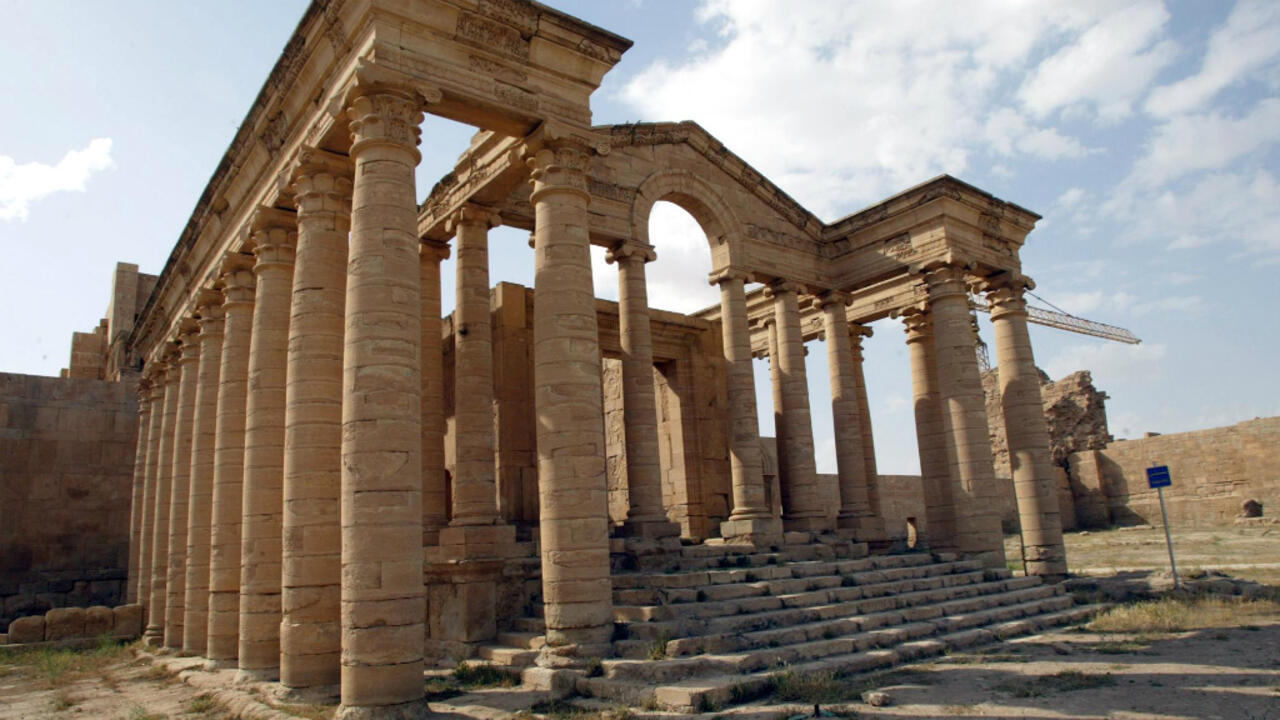
The city of Hatra in modern-day Iraq is an example Parthian architectural Era.
Architectural Characteristics
– The Parthian architecture showcased a blend of Greek, Roman, and native Persian elements, reflecting the empire’s interactions with neighboring civilizations.
– Use of vaults and domes became more prevalent, marking a shift from the columned halls of the Achaemenid era.
– Brick was the primary construction material, often glazed for decorative effect.
Notable Examples
– The city of Hatra in modern-day Iraq is a prime example, known for its fortified structures and blend of Hellenistic and Roman architecture with Persian influences.
– Parthian fortresses, such as those found in Nisa, displayed unique construction techniques and were crucial in the defense strategy of the empire.
Sassanian Architecture Architectural Era (224 – 651 AD)
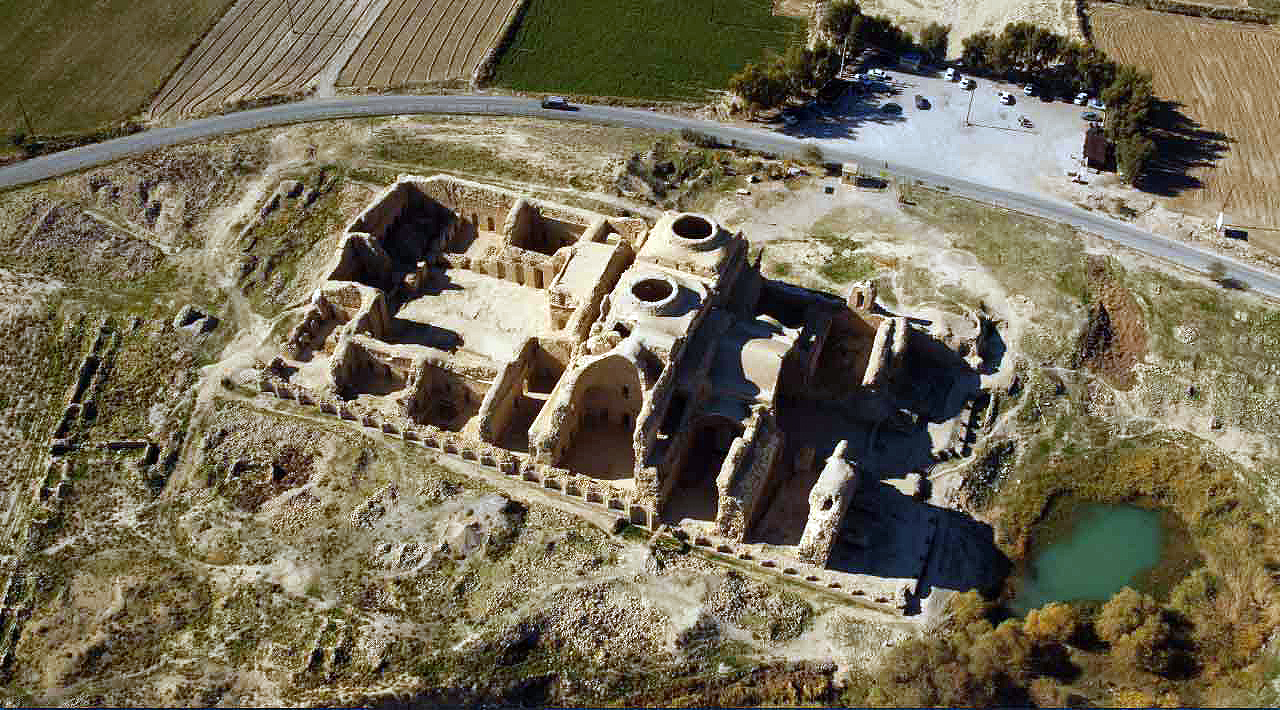
The Palace of Ardashir, an example of the Sassanian Architectural Era
Architectural Innovations
– The Sassanian architecture is marked by its grand scale, architectural innovations, and distinctive artistry.
– Introduction of massive domes and vaults, and the development of the iwan (a vaulted open room), which would later become a staple in Islamic architecture.
– Significant advancements in engineering, particularly in constructing bridges, dams, and other public works.
Key Structures
– The Palace of Ardashir and the Ghal’eh Dokhtar Fort demonstrate the use of thick walls and domes.
– The Taq Kasra (Arch of Ctesiphon), with its enormous brick-built arch, is one of the most impressive remnants of Sassanian architecture, showcasing their mastery in creating vast, open interior spaces.
– Bishapur city, featuring a combination of Roman and Persian architectural styles, symbolizes the cultural synthesis of the Sassanian era.
Cultural Impact
– Sassanian architecture significantly influenced the development of Islamic architecture, particularly in the use of the iwan and dome structures.
– Decorative arts flourished, with intricate stucco work, carvings, and mosaics adorning both religious and secular buildings.
Technological Achievements
– The construction of the Shushtar Historical Hydraulic System, a complex irrigation system, showcases their advanced understanding of hydraulics.
– The development of ‘qanats’ (underground water channels) for irrigation and urban water supply was another significant achievement.
The Parthian and Sassanian eras represent a period of architectural transformation in Iran, characterized by the integration of various cultural influences and significant advancements in construction techniques. These eras not only bridged the gap between the ancient and Islamic periods in Persian architecture but also laid the groundwork for the architectural wonders that followed in the Islamic era. Their legacy is a testament to the adaptability and creativity of Persian architects and engineers, who not only mastered the techniques of their time but also innovated new ones that would have a lasting impact on the architectural heritage of the region.
Islamic Influence in Iranian Architecture
The Islamic period in Iranian Architecture marks a profound transformation, both in terms of style and technique, following the advent of Islam in the 7th century. This era is characterized by the integration of Islamic architectural elements with the rich Persian architectural heritage, leading to a unique and influential style.
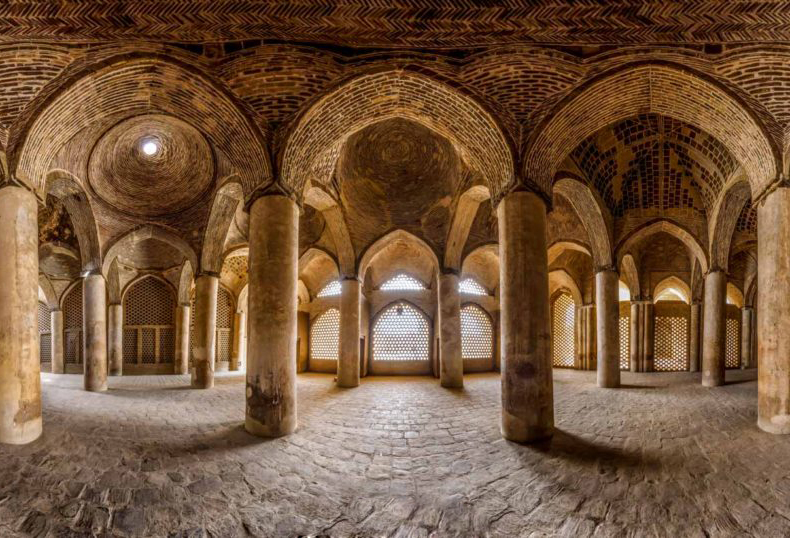
The Jameh Mosque of Isfahan is an example of Islamic Influence in Iranian Architecture
Early Islamic Architecture (7th–10th Centuries)
Introduction of New Elements: The arrival of Islam introduced architectural elements like mosques, Islamic schools, and mausoleums. The use of Arabic script in architectural decoration became prominent.
Adaptation and Innovation: Early Islamic architects in Iran adapted pre-existing Persian forms like the iwan and combined them with Islamic architectural elements like the dome and minaret, creating a distinct style.
Materials and Techniques: The use of brick became more widespread, and innovations in tilework began to emerge, later becoming a hallmark of Persian architecture.
The Golden Age (10th–15th Centuries)
The flourishing of Mosque Architecture: This period saw the construction of some of the most iconic mosques, characterized by vast iwans, grand domes, and elaborate tilework.
Development of Madrasas: The Seljuk and later periods witnessed the rise of madrasas, which combined educational and religious functions, often featuring a four-iwan plan surrounding a courtyard.
Artistic Innovations: Advances in geometry and mathematics influenced architectural design, leading to complex tilework patterns and intricate muqarnas (ornamental vaulting).
Notable Islamic Architectural Examples
The Jameh Mosque of Isfahan: Renowned for its stunning tilework and four-iwan layout, this mosque demonstrates the evolution of mosque architecture over several centuries.
Sheikh Lotfollah Mosque: Famous for its dome’s changing color and exquisite interior tilework, this mosque exemplifies the zenith of Safavid architecture.
Safavid Architectural Era (16th–18th Centuries)
Architectural Grandeur: The Safavid dynasty is known for its contribution to the development of mosque and madrasa architecture, with Isfahan becoming a pivotal center for architectural innovation.
Urban Planning: Safavid architects excelled in urban planning, as seen in the layout of Isfahan, including the Naqsh-e Jahan Square, one of the largest city squares in the world.
Technological and Artistic Advances
Refinement of Tilework: The Islamic period saw the perfection of tilework, with intricate designs and a wide range of colors.
Structural Innovations: Innovations in structural engineering allowed for larger domes and taller minarets, pushing the boundaries of architectural design.
Key Safavid Architectural Contributions
Naqsh-e Jahan Square (Imam Square) in Isfahan: A UNESCO World Heritage Site, this square is an outstanding example of Safavid urban planning, surrounded by architectural masterpieces such as the Sheikh Lotfollah Mosque, the Imam Mosque, and the Ali Qapu Palace.
Sheikh Lotfollah Mosque and Shah Mosque (Imam Mosque): These mosques are celebrated for their stunning tilework, majestic domes, and the integration of architectural elements that create a harmonious and spiritual atmosphere.
The Islamic period in Iranian architecture is not just a testament to the religious and cultural transformation of Iran but also a period of remarkable artistic and engineering achievements. It represents a fusion of Islamic architectural principles with traditional Persian elements, resulting in a distinctive style that has had a lasting impact on the architectural heritage of the Islamic world. This era’s legacy is evident in the numerous mosques, palaces, and madrasas that continue to stand as symbols of Iran’s rich architectural and cultural history.
Mongol Era of Iranian Architectural History
The Mongol and Safavid periods in Iran marked significant epochs in the nation’s architectural history, each contributing uniquely to its evolution and character.
Mongol Era (13th–14th Centuries)
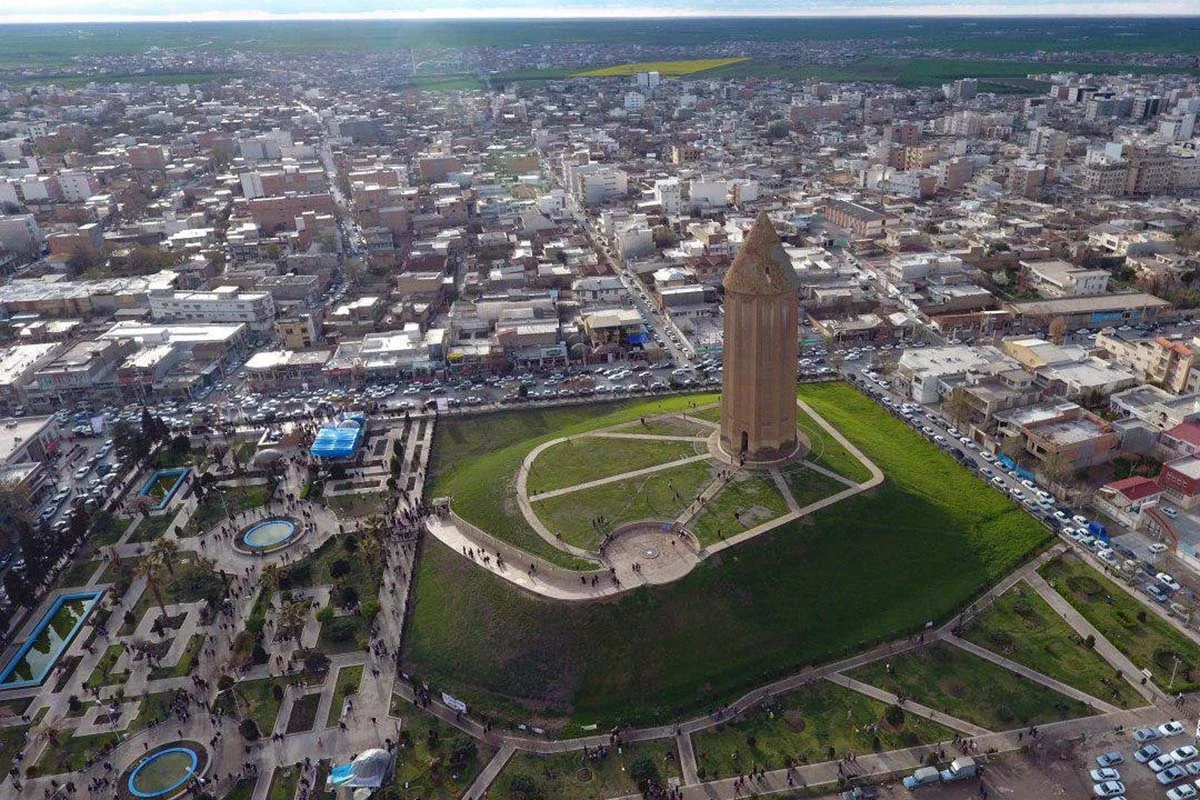
Gonbad-e Qabus Tower, an example of the Mongol Architecture Era of Iran
Architectural Impact of the Mongols
Influence on Urban Development: The Mongol conquest led to the destruction and subsequent rebuilding of many cities, which influenced urban design and architecture.
Synthesis of Styles: The Mongols brought with them influences from East Asia, which blended with the existing Persian and Islamic styles, leading to a unique architectural synthesis.
Religious Structures: During the Ilkhanate, a Mongol dynasty, there was a significant focus on the construction of religious buildings, particularly mosques and madrasas, which incorporated Mongol elements.
Notable Mongol Era Structures
Oljeitu Mausoleum (Soltaniyeh Dome): This structure is famous for its massive double-shelled dome and innovative use of muqarnas. It represents a fusion of Persian, Mongolian, and Islamic architectural elements.
Gonbad-e Qabus Tower: A prominent example of the Mongol influence on Persian architecture, known for its simple, yet striking brickwork and conical roof.
Both the Mongol and Safavid eras were pivotal in shaping the course of Persian architecture. The Mongol influence introduced new elements and a certain robustness in construction, while the Safavid period was marked by a resurgence in Persian arts and architecture, leading to some of the most iconic and celebrated architectural works in Iran. These contributions not only define a significant part of Iran’s architectural heritage but also demonstrate the dynamic nature of its cultural evolution, influenced by various rulers and dynasties over the centuries.
Qajar to Pahlavi Periods
The Qajar and Pahlavi periods in Iranian architecture mark a fascinating era of transition, blending traditional Persian designs with modern influences, reflecting the country’s journey towards modernization and its interactions with the West.
Qajar Architecture Era (1789–1925)
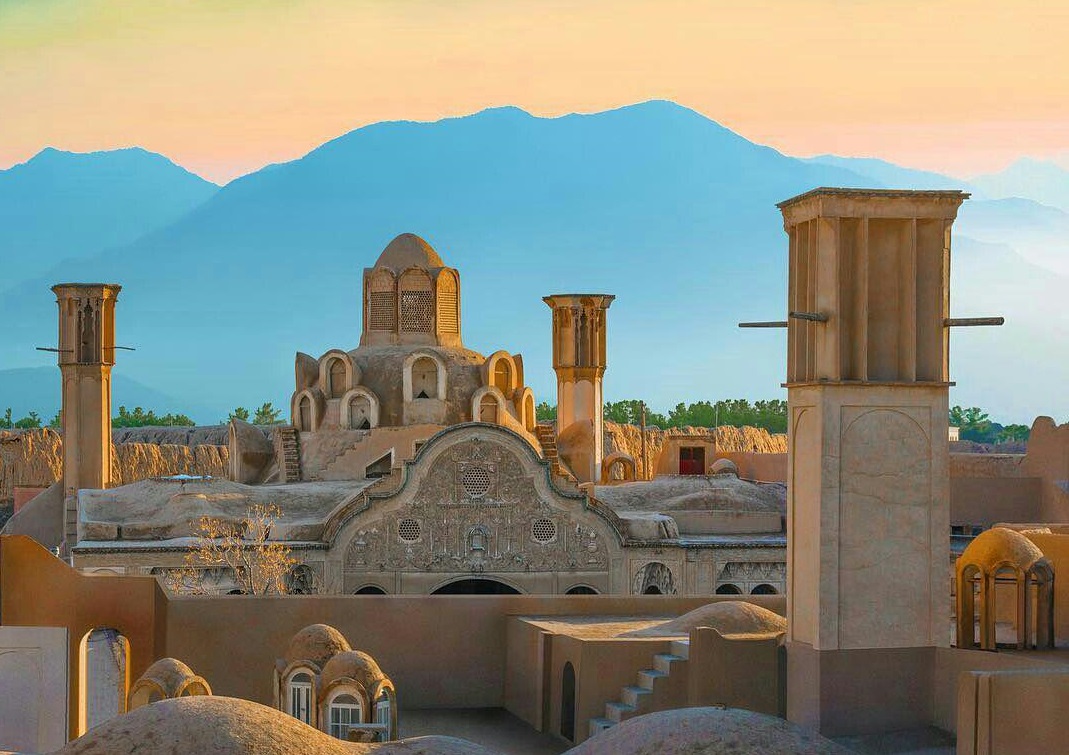
Boroujerdi House in Kashan, an example of the Qajar Architectural Era of Iran
Characteristics of Qajar Architecture
European Influences: This era saw the introduction of European architectural styles and motifs, particularly those from Russia and Western Europe, blending with traditional Persian elements.
Ornamental Detailing: Qajar buildings are known for their elaborate decorative features, including intricate tilework, mirror work, and paintings.
Public and Private Buildings: The era witnessed the construction of numerous public buildings, palaces, and mansions, each reflecting the opulence and power of the Qajar dynasty.
Notable Qajar Architectural Examples
Golestan Palace in Tehran: A prime example of Qajar architecture, featuring a blend of traditional Persian arts with European architectural elements, particularly noticeable in its ornate mirror hall.
Boroujerdi House in Kashan: Known for its beautiful stucco carvings, windcatchers (Badgirs), and fine paintings, this house is a quintessential example of Qajar residential architecture.
Pahlavi Architectural Era (1925–1979)
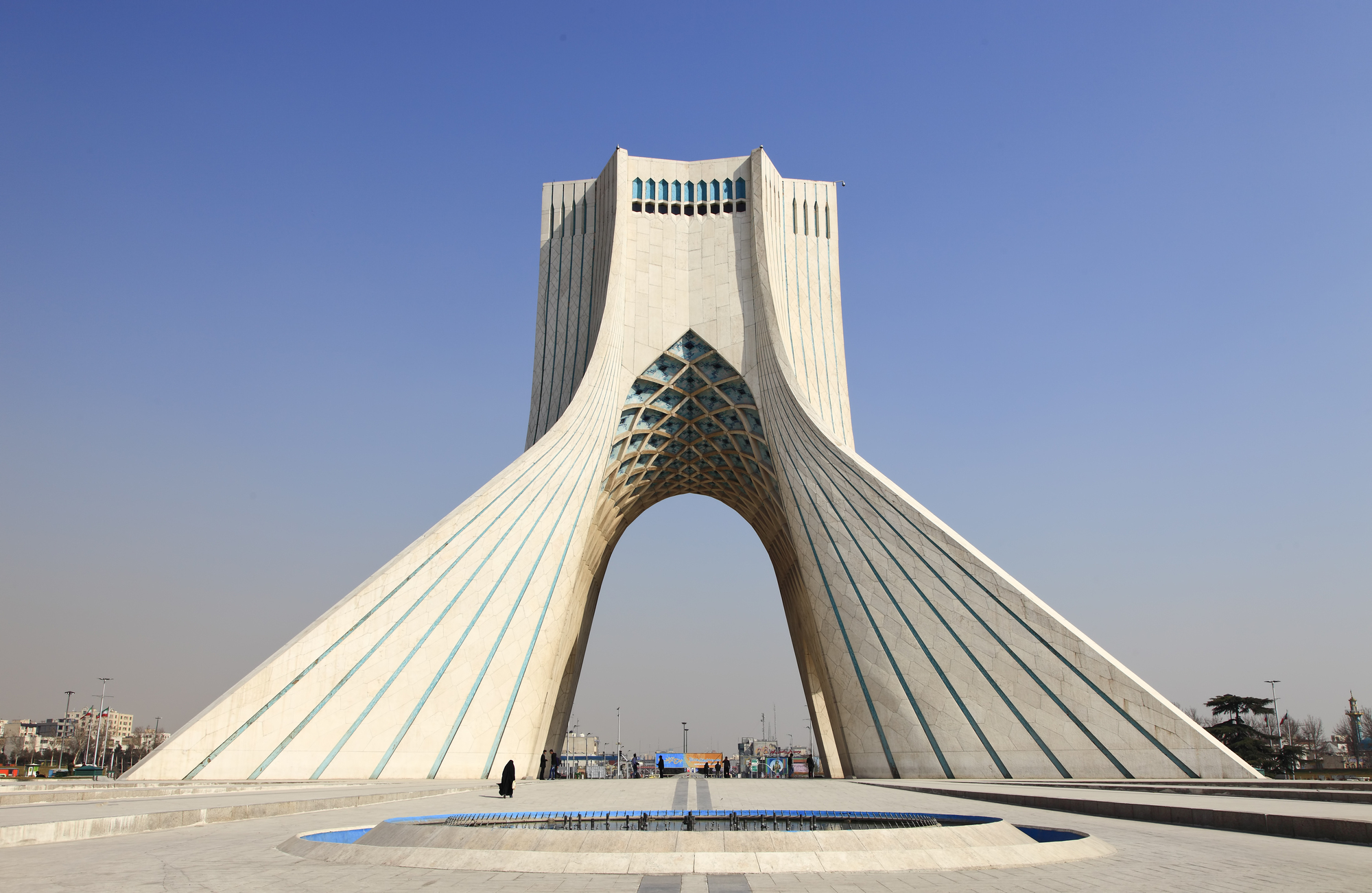
Azadi Tower in Tehran, an Example of Pahlavi Architectural Era
Modernization and Westernization of the Pahlavi Era
– The Pahlavi period was marked by a strong push towards modernization and Westernization, which significantly influenced architectural trends.
– Architects during this era sought to create a modern Iranian identity, often incorporating modern materials and technologies while referencing traditional Persian architectural elements.
Architectural Developments in the Architecture of the Pahlavi Era
Public Buildings and Urban Development: There was a focus on constructing public buildings, universities, and cultural institutions, often featuring modern architectural styles.
Revival of Ancient Persian Motifs: The use of motifs and styles from ancient Persian architecture, like Achaemenid and Sassanian, was prevalent in state-sponsored projects as a means of linking the modern nation to its illustrious past.
Key Pahlavi Era Structures
Azadi Tower in Tehran: Symbolizing Tehran’s rapid growth and modernization, the Azadi Tower blends traditional Iranian architectural elements with modern design, becoming an iconic landmark.
Niavaran Palace Complex: Showcasing a mix of modern and traditional styles, this palace complex reflects the Pahlavi era’s attempt to marry Iranian heritage with contemporary aesthetics.
Cultural and Political Context of the Pahlavi Era
Both Qajar and Pahlavi architecture reflect the cultural and political shifts of their times. The Qajar era’s blend of Persian and European styles symbolized Iran’s opening to the West, while the Pahlavi period’s embrace of modernization and simultaneous revival of ancient motifs mirrored the nation’s struggle to forge a modern identity rooted in its historic past.
These periods in Iranian architectural history highlight a nation at the crossroads of tradition and modernity. The dynamic interplay of styles during the Qajar and Pahlavi eras not only reflects the social and political changes of the times but also contributes to the rich and diverse architectural heritage of Iran.
Contemporary Iranian Architecture
Contemporary Iranian architecture represents a vibrant and evolving field, characterized by its innovative fusion of traditional Persian elements with modern design principles. This era reflects Iran’s ongoing dialogue between its rich historical heritage and the demands of modern urban living.
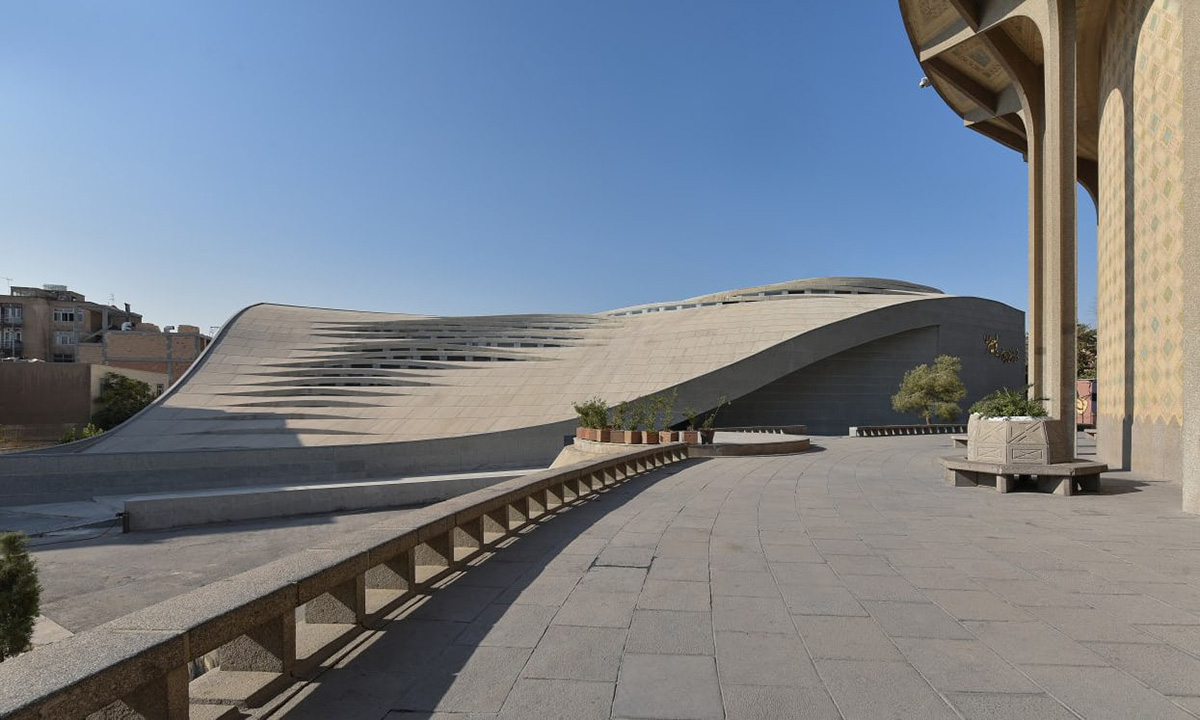
Vali-e-Asr Mosque is a prime example of the Contemporary Architectural Era of Iran
Blending Tradition with Modernity
– Contemporary Iranian architects often draw inspiration from Iran’s architectural history, incorporating traditional motifs and techniques into modern designs. This blend creates a unique architectural language that respects the past while embracing the future.
– The use of traditional materials like brick and tile is common, but with innovative approaches to form, space, and technology.
Innovations and Characteristics
Sustainable Architecture: There’s an increasing focus on sustainability, using local materials, and designing energy-efficient buildings that respect Iran’s diverse climates.
Public Spaces and Urban Planning: Contemporary architecture in Iran places a strong emphasis on creating public spaces that foster community interaction and cultural activities.
Notable Contemporary Projects
Tabiat Bridge in Tehran: Designed by Iranian architect Leila Araghian, this pedestrian bridge is a notable example of contemporary design, providing not just a physical connection but also a public space for leisure and cultural events.
Vali-e-Asr Mosque: This mosque breaks traditional norms with its minimalist design and absence of a conventional dome, reflecting a modern interpretation of Islamic architectural principles.
Challenges and Opportunities
– Contemporary Iranian architects often face challenges related to urbanization, economic constraints, and maintaining cultural identity. However, these challenges also present opportunities for creative and contextually sensitive designs.
– The global interest in sustainable and innovative architecture has opened up new avenues for Iranian architects to showcase their work on an international stage.
The Role of Technology
– Advances in technology have significantly impacted contemporary architecture in Iran. Computer-aided design (CAD) and new construction technologies allow for more complex and precise architectural forms.
– The integration of smart technology in buildings is also becoming more prevalent, aiming to enhance energy efficiency and environmental sustainability.
Cultural Influence
– Contemporary Iranian architecture is not just about buildings; it’s also a medium for cultural expression and social commentary. Many architects incorporate artistic elements and motifs that reflect Iran’s socio-political landscape.
Contemporary Iranian architecture is a testament to the country’s ability to adapt and evolve. By blending traditional design principles with modern techniques and ideas, Iranian architects are creating a unique architectural identity that speaks to both their rich heritage and a forward-looking vision. This era of Iranian architecture is marked by a rich diversity of styles and approaches, reflecting the dynamic and multifaceted nature of contemporary Iranian society.
Conclusion
The history of Iranian architecture is a testament to the country’s rich cultural legacy. From ancient Persepolis to contemporary Tehran, each era has contributed uniquely to the tapestry of Iranian architectural history, creating a blend of tradition and innovation that continues to evolve and inspire.

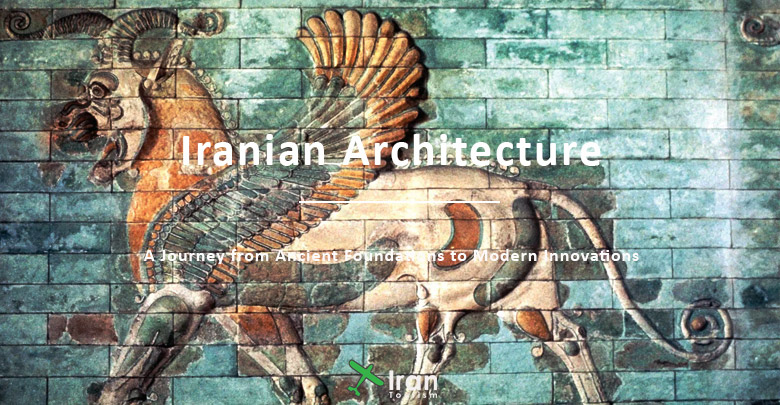

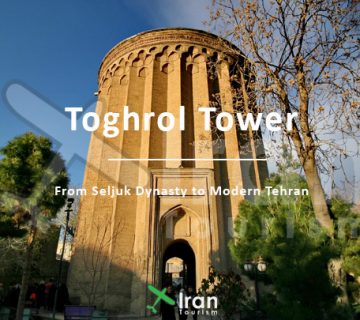
No comment